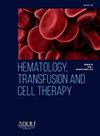低甲基化药物和venetoclax联合治疗急性髓系白血病和骨髓增生异常综合征的现实世界结果——来自资源有限国家的单中心经验
IF 1.6
Q3 HEMATOLOGY
引用次数: 0
摘要
目的评价维妥乐联合HMA治疗AML合并MDS患者的安全性、有效性和有效率。本研究提供了巴基斯坦一家三级保健中心的结果,从而深入了解了这种治疗方案在资源有限的国家的结果和影响。方法对96例患者进行回顾性分析,其中AML患者54例,MDS患者42例。所有患者于2020年1月至2024年12月在单一中心接受venetoclax联合HMA治疗。AML的主要结局是总生存期(OS)、无进展生存期(PFS)和缓解率(完全缓解[CR]、部分缓解[PR]、疾病稳定[SD]和无缓解[NR]),而MDS的反应是根据IWG标准评估的。结果saml队列(n = 54)男女比例为2:1,中位年龄为52岁(IQR:37 ~ 62.2)。风险分层显示,良好风险3例(5.6%),中等风险37例(68.5%),不良风险14例(25.9%)。41例(75.9%)在一线接受治疗。一线治疗的适应症是年龄或虚弱27例(50%),感染3例(3.9%),心脏毒性2例(3.8%)。阿扎胞苷44例(81.5%),地西他滨10例(18.5%)。第一、第二和EOT后的总有效率(ORR)分别为26(48.1%)、34(63%)和36 (66.7%),CR率分别为15(27.8%)、27(50%)和30(55.6%)。大剂量阿糖胞苷巩固治疗5例(9.3%),维妥乐维持治疗10例(18.5%)。7例(12.9%)患者接受了HSCT,其中5例(71.4%)接受了同种异体移植,1例接受了单倍体移植,1例接受了自体移植(28.5%)。末次随访ORR 27例(50%),CR 24例(88.8%),CRi 3例(11.1)。14例(25.9%)患者无反应,10例(18.5%)患者复发。AML队列的OS为77.4%,中位生存期为1250天(95% CI 139-2360), DFS为52.8%,中位生存期为438天(95% CI 65-761)。MDS队列(n = 42)的男女比例为9.5:1,中位年龄为51岁(IQR: 36.5-57.5)。基因突变3例(7.3%),其中TP53突变1例,del7q突变1例,ASXL1、TET2、EZH2、RUNX1和STAG2突变1例。R-IPSS和IPSS评分中位数分别为5 (IQR: 4.2-6)和1.5 (IQR: 0.75-2)。31例(73.8%)患者使用阿扎胞苷,11例(26.2%)使用地西他滨。第1周期、第2周期和EOT的ORR分别为12(28.6%)、21(51.2%)、18 (42.9%),CR率分别为2(4.8%)、11(26.2%)和11(26.2%)。发热性中性粒细胞减少23例(54.8%),周期中断23例(54.8%)。7例(17.1%)患者接受了同种异体移植,2例(4.9%)患者接受了单倍体移植。5例(12.2%)患者接受维托clax维持治疗。复发8例(21.1%)。MDS队列的OS为59.5%,中位生存期为907天(95% CI 386-1424); DFS为44.4%,中位生存期为528天(95% CI 336-719)。结论venetoclax联合HMA在现实环境中是一种有效的治疗AML和MDS的策略,即使在资源有限的环境中也是如此。本文章由计算机程序翻译,如有差异,请以英文原文为准。
REAL WORLD OUTCOMES OF HYPOMETHYLATING AGENTS AND VENETOCLAX COMBINATION THERAPY IN ACUTE MYELOID LEUKEMIA AND MYELODYSPLASTIC SYNDROME- SINGLE CENTER EXPERIENCE FROM A RESOURCE LIMITED COUNTRY
Objective
In this study, we aim to evaluate the safety, efficacy and response rates of venetoclax and HMA combination therapy in patients with AML and MDS. This study provides outcomes from a tertiary care center in Pakistan, giving insights into the outcomes and impact of this therapeutic regimen in a resource-limited country.
Methodology
We conducted a retrospective analysis on 96 patients of which 54 patients had AML and 42 had MDS. All the patients received venetoclax combined with HMA at a single center from January 2020 to December 2024. The primary outcomes measured for AML were Overall Survival (OS), Progression Free Survival (PFS) and response rates (Complete Remission [CR], Partial Remission [PR], Stable Disease [SD] and No Response [NR]) while for MDS response was assessed as per IWG criteria.
Results
AML cohort (n = 54) had a male-to-female ratio of 2:1, median age of 52 (IQR:37‒62.2). Risk stratification showed good risk in 3 (5.6%), intermediate in 37 (68.5%) and poor risk in 14 (25.9%) patients. Treatment was given in first line in 41 (75.9%). Indications for first line treatment were age or frailty in 27 (50%), infections in 3 (3.9%) and cardiotoxicity in 2 (3.8%). Total 44 (81.5%) patients received azacytidine and 10 (18.5%) decitabine. Overall Response Rate (ORR) after cycle 1, cycle 2 and EOT was 26 (48.1%), 34 (63%) and 36 (66.7%), CR rate was 15 (27.8%), 27 (50%) and 30 (55.6%) respectively. High dose cytarabine consolidation and venetoclax maintenance were given to 5 (9.3%) and 10 (18.5%) patients respectively. Seven (12.9%) patients underwent HSCT of which 5 (71.4%) received allogenic, 1 haploidentical and 1 received autologous transplant (28.5%). ORR at last follow-up was 27 (50%) of which 24 (88.8%) had CR and 3 (11.1) had CRi. There was no response in 14 (25.9%) and disease relapse in 10 (18.5%) patients. The OS of AML cohort was 77.4% with median 1250 survival days (95% CI 139‒2360) and DFS was 52.8% with median survival 438 days (95% CI 65‒761). The MDS cohort (n = 42) had a male-to-female ratio 9.5:1 with 51-years median age (IQR: 36.5‒57.5). Genetic mutations were present in 3 (7.3%) of which TP53 mutation, del7q were present in 1 each whereas 1 patient had ASXL1, TET2 EZH2, RUNX1 and STAG2 mutations. The median R-IPSS and IPSS scores were 5 (IQR: 4.2‒6) and 1.5 (IQR: 0.75‒2) respectively. Thirty-one (73.8%) patients received azacytidine and 11 (26.2%) decitabine. ORR at cycle 1, cycle 2 and EOT was 12 (28.6%), 21 (51.2%), 18 (42.9%) with CR rates of 2 (4.8%), 11 (26.2%) and 11 (26.2%) respectively. Febrile neutropenia was observed in 23 (54.8%) and cycles were interrupted due to cytopenia’s in 23 (54.8%) patients. Seven (17.1%) patients received allogenic HSCT and 2 (4.9%) received haploidentical HSCT. Five (12.2%) patients received venetoclax maintenance. Eight (21.1%) patients had disease relapse. The OS of MDS cohort was 59.5% with median 907 survival days (95% CI 386‒1424) and The DFS was 44.4% with median survival 528 days (95% CI 336‒719).
Conclusion
Venetoclax in combination with HMA represents an effective therapeutic strategy for AML and MDS in the real-world setting, even in resource limited settings.
求助全文
通过发布文献求助,成功后即可免费获取论文全文。
去求助
来源期刊

Hematology, Transfusion and Cell Therapy
Multiple-
CiteScore
2.40
自引率
4.80%
发文量
1419
审稿时长
30 weeks
 求助内容:
求助内容: 应助结果提醒方式:
应助结果提醒方式:


